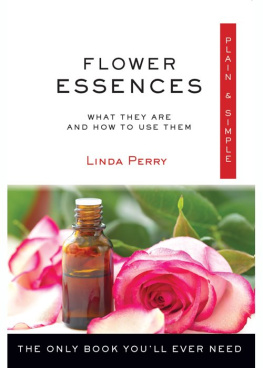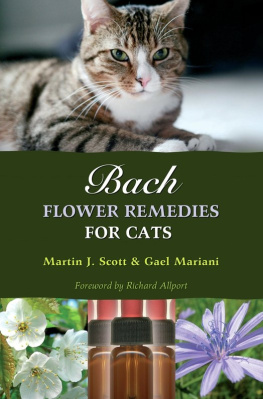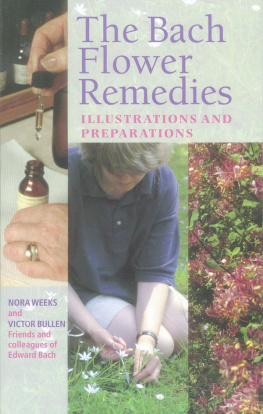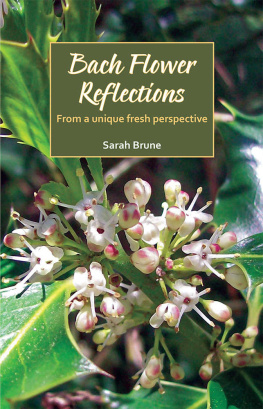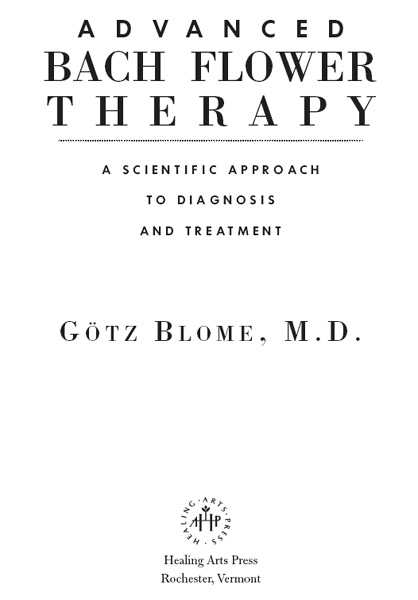
INTRODUCTION
T here is no doubt that modern scientific medicine has had spectacular successes in the fight against physical illness. But it can do nothing against spiritual and emotional suffering; indeed, it even seems that the drastic measures of chemical-technical therapy have driven the pathogenic locus of illness from outside to inside and increased the incidence of mental and emotional problems. More than fifty years ago, the distinguished doctor and researcher Dr. Edward Bach developed his new form of flower therapy, which focused on the mental and emotional factors as causes of illness. Given the results of modern treatments, its little wonder that the popularity of Dr. Bachs flower therapy continues to grow by leaps and bounds.
Bach flower therapy does not seek the physical symptoms of an illness but instead looks to the underlying or predominant mental and emotional conditions and aims to treat the psychic, not the physical, symptoms. Bach flower therapy attempts to treat the patients soul; physical problems are secondary. Dr. Bach had a sound basis for this unusual concept. In searching for a truly humane form of treatment, he stumbled across a phenomenon that has been largely unobserved in modern medicine: according to the structure of the personality and the emotional constitution, the same illness can cause very different psychic symptoms in different individuals. These manifestations, such as restlessness or apathy, openness or reserved behavior, fear of death or an attraction to death, grouchiness or gratitude, lend the objective physical symptoms their individual, personal meaning.
We normally describe a sick person something like this: he has such and such a temperature and runny stools, and he sweats profusely. Lab results are such and such, and the patient is apathetic and weak. We can, however, describe the physical symptoms brought about by the psychic ones, beginning like this: the patients face has a sad, troubled expression; his voice is feeble; he is suffering the consequences of a great loss and gives the impression he wants to die. Or we can say he is unusually self-pitying and in need of consolation and sulks when someone is not paying constant attention to him. Hes anxious and restless and also suffers from a fever, runny stools, and so on.
Although the physical symptoms are identical, we are dealing with two different illnesses. The first case stems from the tendency to want to end ones life owing to a great loss, while the second condition is, above all, a cry for attention. It is clear that the treatment must take into account the background of the illness. When we ignore the mental and emotional state of a patient, we are imposing treatment in an impersonal, objective, essentially senseless way, addressing only the symptoms and not the patient. If, however, we observe the psychic signs, we understand the illness in a larger context and can treat the patient as an individual, suffering being.
Dr. Bach described the connection between the mental and emotional state and illness as a conflict between the personality and the higher self. In each individual traumatized by life, he also saw the core of an essentially good, healthy human being and was convinced that health can return only when the balance of the psyche is restored and the inner self is once again whole and revitalized. It is this premise, expressed differently, that informs todays psychosomatic medicine. While psychosomatic medicine attempts to resolve these conflicts mainly through conditioning or raising consciousness, however, Bach flower therapy goes about trying to minimize or treat precisely defined psychic conditions with thirty-eight floral essences, in ways that have still not been scientifically explained.
The positive effects of Bach flower therapy can be significantly bolstered through the patients conscious work on her own sick personality. This is where this book comes in, pointing out the deeper psychological connections. Often just by concentrating on the underlying mental and emotional conditions, we can untie our inner knots and begin the healing process, even without any kind of medication. This process can then be strengthened and promoted by using the appropriate flower essences. Despite its astounding success, Bach flower therapy does have its limits. Since healing, like illness, is a phenomenon that is very much dependent on fate and circumstance, we cannot always force it on our own. When the patient is determined to be healthy again, and when such crucial factors as timing, mental and emotional condition, and therapist and medication working together in an ideal manner all fall into place, we have the requisites for healing to take place. Sometimes one form of therapy will be called for and sometimes another. There is no such thing as a cure-all, and there never will be. When we are not as successful as we would like to be, we should be open to other methods of treatment. Homeopathy works especially well as a companion form of treatment to Bach flowers.
The strength of Bach flower therapy lies in the normalization of psychic disruptions and the resolution of inner conflicts as well as in the improvement of physical conditions that have recognizable psychic causes or symptoms. Bach flowers are particularly suitable for children. They are appropriate not just as a treatment that attempts to achieve a harmony of mind and body in all types of illnesseseven as a supplement to routine medical treatmentbut also, because they can stabilize or eliminate psychic weak points, as a form of preventive maintenance. For example, we can treat the eternally irritable, aggressive patient with Holly; a restless, nervous type with Impatiens; the patient with a pathological craving for recognition with Heather; a fearful patient with Mimulus; or a depressed type with Mustard. They will be plagued by their emotional and related physical problems less often or not at all.
Please note that not every psychic condition is treatable, nor is it necessarily the sign of an illness. Psychic manifestations can be a significant part of our personality and part of what makes us unique. Treatment is called for only when they cause us to sufferfor example, in the form of conflicts, frustrations, depression, self-denial, or difficulties in coming to terms with our everyday lives.
Structure and Use of This Book
This book is divided into three parts. In the first chapter you will find exact descriptions of the thirty-eight essences that form the basis of Bach flower therapy. Each essence (Bach flower) is associated with a typical psychic condition that can be expressed in groupings of various individual symptoms that, taken together, are known as syndromes. With the help of a new kind of analysis, the various personality types of those who can be treated with Bach flowers will be explained clearly. The ideally developed personality of each type will be described, followed by the problems that become apparent when each is unfavorably developed. Each of us has a unique psychic structure that affects our emotions, thoughts, and actions. We can develop harmoniously or experience inharmonious manifestations that can cause illness or psychosomatic conditions. Being able to treat these pathological manifestations is the strength of Bach flower therapy. It can restore our balance and free us from physical manifestations of problems that are often psychic or emotional in origin. Bach flower therapy cannot, however, make a person into his ideal opposite.
The thirty-eight classic Bach flowers encompass nearly all of the important qualities of the human psyche; taken singly, however, they may not have sufficient complexity or strength. Because most illnesses arise from the interplay of various psychic or physical influences and particularities of personality and character, Bach flowers are normally administered by combining several essences. The most common and important combinations are listed in chapter 1 and described in detail in the second chapter, at the end of each individual flower description. These combinations allow for more precise and effective treatmentsince each has its own area of efficacyand open up a new perspective to understanding most personality and behavioral problems. Each combination can be found in chapter 2 under the name of the essence listed first: for example, you would find the Chicory/Heather combination (8/14) under the letter C or the number eight. The combinations are listed again in the repertory, where they are marked with an asterisk(*).
Next page



